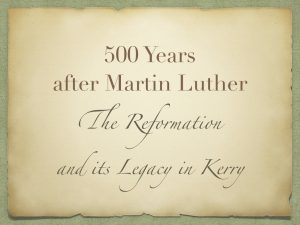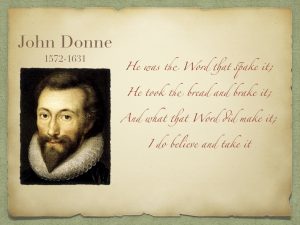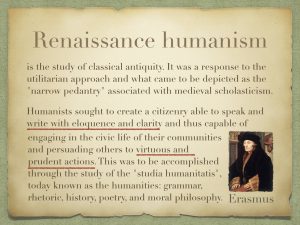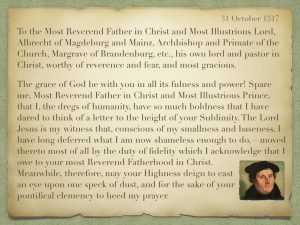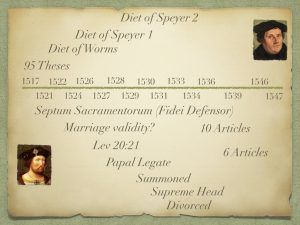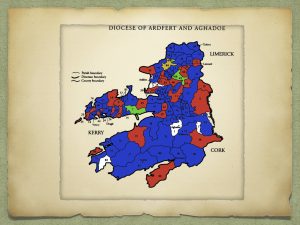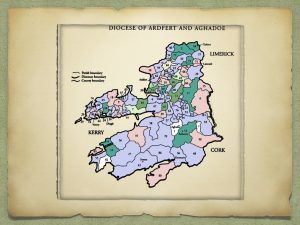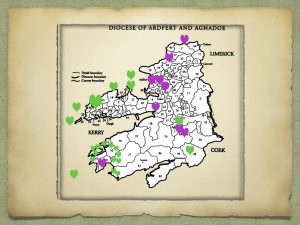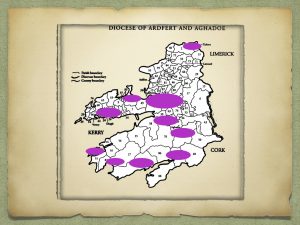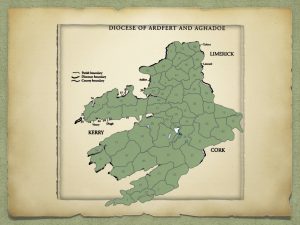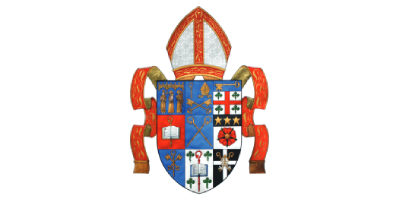The following paper was given by Archdeacon Simon Lumby to the Kerry Archæological Society, to wide acclaim
Vote of Thanks
Firstly may I indulge in an expression of gratitude for the invitation given me to speak to you in this year of the 500th anniversary of the commencement on 31 October 1517 of what we generically call “The Reformation”. When I undertook this commission little did I realise that it would present to me the hardest piece of research I have ever undertaken. So whilst courtesy bids me thank you; some part of me wishes to express an entirely contrary emotion.
Cautionary Injunction
I am reminded of the cautionary injunction placed upon theologians and historians alike, by Thomas O’Loughlin in his book Celtic Theology (2005). In his opening chapter entitled Celtic? Theology he challenges these two schools to engage with each other more deeply. The two look at the same data with different eyes and different expectations. His caution is that the historian doesn’t report the things the theologian is looking for, even when engaging with the so-called “ecclesiastical sources”; and the theologian doesn’t engage with concepts of developmental process in history. In short, one cannot read ecclesiastical history without understanding both theology and history.
I have approached my talk with a view to giving a nuanced backdrop to the question of the impact of the Reformation in Kerry in the last 5 centuries; in order better to understand how to read the local data here in “the Kingdom” (I choose, playfully, to imply both historical and theological senses in that label). I need to start with an extensive precursory, so as to debunk some myths and to clarify some of the defining theologies of some players. It is my contention that, without this foundation, it is not possible to read the history adequately.
Clarifying Assumption: Terminology
Originally the term “Catholic” meant universal. This would have been true of the church of the first millennium. However, when Rome broke away from the Byzantine expression of the church universal in the Great Schism of 1054, the term catholic took on an “us and them” flavour. It will help us if we recognise that the term “protestant” has also been used in recent history, and not just in Ireland, as a “them and us” term.
The term “catholic” has come to be used in Reformed tradition much more as a statement of theology. It is identified with the theology of the Eucharist. By this we can see that the Church of Rome, the Church of England, the Lutherans and the Methodists—oh, and not forgetting the Orthodox—are all reformed catholic churches. They all accept the theology of the Real Presence of Christ in the Eucharist; they are just subtly different in their explanations. It was John Donne, the Jacobean priest poet, who wrote of the Eucharist:
“He was the Word that spake it;
He took the bread and brake it;
And what that Word did make it;
I do believe and take it”
This would be the typical Anglican fence-sitting theology. So the history of the Reformation in Ireland must be nuanced by an understanding of the catholicity of both the Anglican and Roman churches.
The label Protestant was first given to the Prince Electors of the Holy Roman Empire in 1529 because they protested in a letter to the Emperor’s representative about the rescinding of permission to hold whatever religious views they could justify before “King and God”. This right had been allowed in 1526 when the Edict of Worms, banning Luther’s teaching five years earlier, had been rescinded. It is arguably the case that those who break with Rome but not with biblically-based catholic theology are not to be clubbed with the label Protestant. Those protestants who break with the defining theologies of catholicism have been labelled Puritan. Those who evince a passionate motivation, sometimes based on a direct relationship with Christ, are often labelled Evangelical. It is the onset of the Scottish plantation of Ulster that makes protestantism ie puritan, as a theology, significant to the Irish story. The Church of Ireland in the North is much influenced by presbyterianism; in the South not nearly so. There are still evident in Kerry prejudices that stem from a anti-catholic stance.
Ha! So much for labels!
This clarification is important because it helps us discriminate between the actors in the play we are about to review. When I refer to the Roman Church and to the Anglican Church, I am saying reformed catholic.
Clarifying Assumptions: Early Christian Ireland
There is a widespread assumption that the C5th St Patrick introduced Christianity into Ireland. So much so, there is no mention in many Irish ecclesiastical histories regarding the Eastern Church tradition: that Christianity was introduced into Ireland in the post-apostolic era by desert monastics. Such an origin helps explain the many similarities between what is now Orthodox theology and Celtic theology. Notably, only four Irish saints are recognised by Rome (and all operated in Europe). The independence of the Irish Church is further strikingly apparent in that the Orthodox Church has only just this year recognised St Patrick, of all the Celtic Saints. Of course we must not impose the Great Schism of 1054 into this earlier time; the roman and byzantine centres were integrated in the one catholic and apostolic church; notwithstanding that there were practical and real differences even in the first millennium.
Moreover, it is widely believed that St Patrick introduced the Roman Church into Ireland. This thesis falls on many counts. Mainly, upon the evidence of the C7th Bede regarding the Synod of Whitby and also on the C12th Papal Bull. It was Palladius that Pope Celestine made Bishop, not St Patrick. He went to Auxerre and to Tours; so it is plausible that he had Celtic sensitivities; hence his success in Ireland. More importantly, it took 6 centuries or more to imprint papal authority upon the Irish.
Clarifying Assumptions: The Papacy
In 1155 Pope Adrian IV is said to have issued the Papal Bull Laudabiliter satis so as to force the Church in Ireland to conform to Roman practices and tasked the English King, Henry II, with implementing it. Henry thus received from the Pope and then gave to his son the Lordship of Ireland; superseding the authority of the traditional role of the Irish High King. (The papal right to dispense countries was predicated on the Donation of Constantine (Ó Corráin 2017 p98) which is a self-serving C8th forgery.) In 1172 Pope Alexander III encouraged Henry in his endeavour and Peter’s Pence was introduced into Ireland. Thus it is in 1542 that Henry VIII elevated that Lordship to Kingship.
Partiality in historical analysis can be found in the modern dialectical interpretation of the Battle of the Boyne. The fact that William of Orange was supported by the Pope as part of the Grand Alliance against King Louis, who supported James, is not recognised by those who seek to use the battle as propaganda for religious division. It is evident that the Papal hold over Ireland before the C12th was very weak. But in the C16th it was arbitrarily severed. Thus it can be argued that it was in an attempt to regain power that the papacy married off loyalty to Rome with Irish nationalism. This helps explain the massive political influence the Church of Rome held over Irish politics.
Given the struggle of the papacy to exert controlling influence over Ireland in the first millennium, it may be accurate, but not in the least complementary, for some reformist writers to claim that papal interference surged in 1152 with the actions of Archbishop Malachy. Certainly, by the C13th many bishops were usurping the Crown on behalf of the papacy (Mant 1840 p15). In 1291, when Edward I was Lord of Ireland—note this is a title granted by the papacy in order to subdue the Irish church—the Roman bishops vowed financially and legally to support each other if interfered with by “any lay power” (p17). It is interesting when the shoe is on the other foot. Such an example of the prejudicial relationship between the Roman Church and the Crown in Ireland led, in 1537, to the removal of a de facto parliamentary veto enjoyed by Roman clergy proctors or advisers; quid pro quo. This removal helped ensure the Irish Parliament passed the Act of Supremacy of Henry VIII.
Clarifying Assumptions: Martin Luther
Martin Luther was a monk and a scholar. He was greatly influenced by the work of the Renaissance humanist Erasmus. Erasmus is said to have been behind the ferment of C16th criticism of religious authorities because of the publication of his The Praise of Folly (Duffy 2017 p21f). It is important to my thesis for us to note the aim of this form of humanism is to educate the masses, so they may make virtuous choices. In a series of lectures at the Institute of Paris in 1904 (Baudrillart 1907) a Roman scholar perceptively linked the Reformation with the Renaissance. This leads to an insight: that the humanist Renaissance and the religious Reformation share a underlying commonality: the scientific method (p37). The ability, indeed the permission, to question and investigate and come to personal knowledge. Is that why the unethical indulgences and the doctrine of transubstantiation and other so-called popist superstitions are the target of the reformist agenda “sola scriptura”? This inevitably leads to the notion that Protestantism is intrinsically and fundamentally fragmented because of a theological version of the scientific method. It is important to our study that we understand the purpose of the intellectual drive of this time; the desire to create an educated people, and for that we can imply ‘reformed’. This imperative will crop up time and again. I disagree with the assertion (p82) that the Reformation arose predominantly for reasons of power and politics. It was for reasons of ethics that Martin Luther wrote an outline document intended to stimulate academic debate. He sent his 95 theses to his archbishop on 31 Oct 1517 note the language of his covering letter. His letter was forwarded to Rome because it directly threatened a “sale of indulgences” Archbishop Albrecht had brokered with the Papal Office (Tomlin 2017), the Pope would receive 50% for his new Basilica; only in this sense did it became power politics. The Pope declared Luther’s teaching heresy. Hmm! so much for pontifical clemency. The notion of reformation as heresy is in fact a desire to prevent the disintegration of law and order—ie the power of the State—by the proliferation of dubious emphases on biblical ideas stemming from reformist readings (Duffy 2017 p28).
Martin Luther was not determinedly setting up a rival church. His only intention was to reform the theology and practice of the western church. He was part of a reforming tradition within the church that spanned the previous decades, in a ferment of vernacular publishing. If it had not been for Luther’s famous temper and the Church’s defence of its power, this Reformation might never have created separate churches.
The theses were written in Latin and so it is implausible to imagine them being pinned to the Castle Church door in Wittenberg since laity could not have read them. They were only translated into German by a Nuremberg councillor 2 months later. Only in 1518 did Luther publish in the vernacular a “Sermon on Indulgences and Grace”. It ran to 16 editions that year; 9 more by 1520 (Methuen 2017). His is the archetype of the Church’s effective use of social media.
Clarifying Assumptions: King Henry VIII
The Church in England was wrenched from the grip of the Papal authority by the political exigencies of King Henry VIII. Henry, and much of his church, remained deeply wedded to their traditional forms of worship and theology. In 1521 he wrote Septum Sacramentorum against Luther and was granted by the Pope, that October, the title Fidei Defensor (incongruously the British Monarch—as Governor of the Church of England—is to this day enamoured of that title!). In November 1522 in a civil court the Diet of Worms sought to enforce the Papal Bull Decet Romanum Pontificem and Luther was outlawed. In 1524 King Henry begins to doubt the sacramental validity of marrying his brother’s widow, for want of an heir. Interestingly, Luther marries in 1525. In 1526 the Diet of Speyer puts on hold the banning of Luther’s teaching. Is it coincidence that only then does he begin the work of creating a new Church. In early 1527 Henry, a deeply devote man, is “persuaded” by Lev 20:21 that he must divorce his Queen and in May the ecclesiastical court referred the matter to Rome. The papal legate arrived in Sep 1528. In March 1529 another Diet of Speyer upholds the Edict of Worms. In July, the Pope decides to hear Henry’s case in Rome. Henry was livid. In fact, the Pope is prevaricating; he was under the influence of Emperor Charles V (Queen Catherine’s nephew) following the Sack of Rome in 1527. Thomas Cranmer floats the idea that English scholars should try the case and deal with it locally, and that Henry should be head of the Church in England. So in November 1529 Acts of Parliament were passed remedying certain pecuniary abuses by the Church . In 1530 Thomas Cromwell entered the fray and used a papal bull of 1518 pertaining to monastic reform to annex their wealth for the Crown. From Feb-Apr 1530, the Universities of Oxford and Cambridge deliberated on the divorce. Both seemed strongly opposed, so a judicious selection of Doctors of Divinity had to be made. Both judgements went in the King’s favour; 27:22. In June monies were sent to scholars across Europe who could show that the King’s case, based on Lev 20:21, was valid. In December 1530 Henry was ordered to Rome; he was incandescent. So on 11 Feb 1531 Henry stood up in Parliament and demanded he be recognised Supreme Head and Sole Protector of the Church in England. After much resistance an Act was passed. Thus began the Church of England. The divorce was allowed by Archbishop Cranmer on 13 May 1533. By the end of 1533 the power of the Papacy was relegated to that of a foreign bishop; by this time there was little opposition. Early in 1534 an Act was passed forbidding the payment of Peter’s Pence and prohibiting the sale of dispensations in the King’s realms; thus further weakening the Pope’s influence. (It is to be noted that Henry also stated in the Act “as to sacraments and spiritual things they have no head but Christ.” (Hitchcock 1932 p54).)
The fact that an Act of Supremacy was passed in November 1534 declaring England as a sovereign state is to be set against the historical tendency of the Papacy to exert overlordship of countries. It was King John who had ceded authority over England to Pope Innocent III and a yearly tribute of 10,000 marks in 1213 (Campion and Ware 1977). In July 1536 the Ten Articles of Religion were issued; they are very Roman in form . It was followed in 1537 by the Bishops’ Book, which can be considered somewhat reformist, but not Lutheran. In 1538 a conference with German reformers—incidentally in which the Anglican Bishops actually favoured a union with the Orthodox church—was dissolved by Henry because he wanted to retain catholic practices. In June 1539, with the publication of the Six Articles of Religion, the King set out the doctrine of the new Church of England, in which it retained most of the practices and principles of catholicism (web). Henry died in 1547, the year after Luther, and was succeeded by Edward VI. It is clear from this that there is no credible cross-over from Luther’s activities and Henry’s business. Henry VIII took over Headship of the Roman Church in England; but it stayed catholic.
So, this is the backdrop to the Church of England’s assertion that it is and always was a reformed Catholic church; its genesis has nothing to do with the reformation, except circumstantially. All of Henry’s decisions point to the preventing of papal power over Henry’s subjects and the stemming of a vast flow of money out of the country. One can’t help but see a prescient hard Brexit approach here! We don’t want your authority; but we do want your theology—well—some of it at least!
Reformers in the aristocracy were encouraged by Edward’s personal reformist views; the reformist Archbishop Cranmer was expeditious in creating a church that was institutionally protestant. Many reformist bishops were consecrated. The 42 Articles of Religion are very reformist; written by Cranmer in the reign of Edward VI. However, they did not come into force in time and Mary’s accession in 1553 nullified them; restoring the Six Articles. She returned the country to the Roman jurisdiction. However, she did not relinquish the annexation of the wealth of the church in England that her father bequeathed her. She died in 1558.
Elizabeth was pragmatic and favoured keeping many catholic and reformist aspects in balance; she was anti-radical and set against the Puritans. This is the classic via media of Anglicanism. Parliament undid Mary’s counter-reforms and returned those of Edward. The Bishops were under-represented and so the Lords temporal swayed the vote; Elizabeth was styled Supreme Governor (note not Supreme Head). So the puritan reformers, returning from exile in Europe, were thwarted by the longevity of the Elizabethan settlement. It was her long reign that prevented the Church of England from being more roman or more puritanical. It even survived the Commonwealth of Cromwell. It is only in her reign that reformist theologies came into the Church of England. It is she that made the Anglican Book of Common Prayer both catholic and reformed, in sometimes ambiguous ways. The 39 Articles of 1563 (still in force) contain 8 catholic prescriptions, 9 Reformed, and 12 Anglican. Article 37 still includes the statement “The Bishop of Rome hath no jurisdiction in this realm of England”, which is quietly ignored now, except in the political sense.
Exploring Internal Sources
One book on the Reformation in Ireland begins with these words “For some centuries before the Reformation the people of England and Ireland walked in spiritual and intellectual darkness.” (Hitchcock 1932). I think I would have to disagree with the claim “the Reformation made little or no difference in parts beyond the Pale and influence of the Crown”. But perhaps it is partially correct to say “Into the country districts an English Bishop or incumbent … ventured on peril of his life.” (p27). In those days Roman clergy in Ireland continued to marry as allowed by Irish Law; and the Papacy granted numerous dispensations to cover it (Campion and Ware 1977).
When Henry broke with the Pope, the desire of the papacy to retain control made it politically expedient to change horses. Paul II now sided with the O’Neill of Ulster and invited an invasion of England and Ireland and to make the O’Neill High King. State papers indicate that “friars and priests of the Irish did preach daily that every man ought for the salvation of his soul to fight and make war against the King’s Majesty and his true subjects.” This is faith being suborned to politics; it is none other than a form of indulgence. This is again an attempt to bargain with the people’s fear of damnation. It is at this point that the Roman Church in Ireland allies itself with the nationalist cause and makes it a spiritual imperative to rebel (p57). Thus in the C17th it is inevitable that allegiance to Anglican or to Roman ecclesiastical authority is seen in political terms: as pertaining in law to loyalty to the Crown. One of the reasons for the persecution of those who owed their allegiance to Rome was that Rome had decreed that all such people were not under the secular authority, and this is treasonable. So even regicide was not punishable according to Rome!
Notwithstanding a papal proscription many Roman religious leaders took the oath of allegiance to the Crown. In Munster two Archbishops and eight Bishops swore the oath in front of the reformist Archbishop Browne of Dublin in 1543. The ecclesial supremacy of Henry was acknowledged by Roman Bishops and Irish Chieftains throughout Ireland.
The dissolution of Irish monasteries swelled the Crown’s coffers. Although Thomas Cromwell dealt harshly with many monasteries, none of the Kerry ones were affected. It was during Elizabeth’s reign that 7 Kerry monasteries and monastic foundations were shut down. Notwithstanding that Henry provided pensions, and even church appointments to the senior monastics, he did nothing to fill the gap of educating and resourcing the poor that the monasteries had done. The Anglican Church was neutered by the dissolution of monasteries. It had no spiritual itinerants. Hence he destroyed the church’s social action. This gave the opening for the Roman itinerant preachers to retain the allegiance of the people. Whilst in Ireland the Church remained under reformist leadership, locally the people slowly slipped to an alternative leadership. They went where they were loved and understood.
It has to be questioned: was Henry using the reformist idea of religious objects as superstitions merely as a wealth creation scam? After all, his 10 Articles permit their use. Why did the reformists have such a bad notion of religious statues etc? I think it has to do with the humanist approach to intellectual enquiry; they’re not biblical. That approach basically denuded the spiritual significance of an object of veneration, of any power, intrinsic or otherwise. (But it might have more to do with culture, as I’ll explain later.)
Bishop Burnett makes in 1679 a general review of the Church in Ireland, he writes “the Reformation made but a small progress in that kingdom … it was received among the English, but I do not find any endeavours were used to bring it among the Irish.” And so in Kerry.
When Mary ascended to the throne she removes the reformist bishops in Ireland and replaces them in consultation with the Pope.
Of all those same bishops, and of the ones who had retained their Sees during her reign, only Kildare and Meath refused the Oath of Supremacy on the accession to the throne of Elizabeth (p275). Moreover, Roman bishops began cooperating in the consecration of reformist bishops in Ireland (p270).
One of the problems for the Church in Ireland was that many previous bishops had let so much of the church land to laity at peppercorn rents that their dioceses were impoverished. There is evidence that this was instrumentally the reason for amalgamations, since no prospective bishop would accept preferment to a bankrupt diocese. Remember the livings were entirely provide by tithes and rents. One could also cite the impoverishment caused by internal conflict and clan rivalries. The Desmond and Ormond rebellions laid waste many churches and communities. In 1600 John Crosby was nominated to the United Sees of Ardfert & Aghadoe (officially describing it the bishopric of Kerry). He was a “graduate in schools of English race, and yet skilled in the Irish tongue: well disposed in religion, and who hath some other means of living to enable him to bear the countenance of such a promotion, which the place hath need of. Because the temporalities of the See, by reason of these rebellions, are wasted and yield little profit” [quoted from State papers] (p283). It had become the tendency from about 1590, the Crown having made appointments to dioceses, for the Pope to appoint Vicars Apostolic to operate in the shadows, since no separate Roman Diocese could yet exist.
An Elizabethan Act on free schools in every diocese comes with the following preamble. “Forasmuch as the greatest number of this your majesty’s realm hath of long time lived in rude and barbarous states, not understanding that Almighty God hath by his divine laws forbidden the manifold and heinous offences, which they spare not daily and hourly to commit and perpetuate, nor that he hath in his holy Scriptures commanded a due and humble obedience from the people to their princes and rulers; whose ignorance in these so high points touching their damnation proceeded only of lack of good bringing up of the youth of this realm, either in public or private schools, where through good discipline they might be taught to avoid these loathsome and horrible errors.” (p289).
It seems as though the people of the Roman Church were in fear of their souls by the traditional teaching of Rome; and the reformers, being likewise fearful for the people’s souls at following this teaching, could not dissuade them with God’s grace, because of the imposition of governmental constraints.
An Act for the repairing of parochial churches failed to get through Parliament. These are the parishes that existed in the C15th. These
The modern Roman parishes.
In 1551 Edward VI notably mandated the translation of the liturgy into Irish. In 1603 Nicholas Walsh, Bishop of Ossory, had printed the NT he translated from the Greek into the Irish (with the great approval of Elizabeth). Back in 1571 the Chancellor of St Patrick’s Dublin had introduced Irish type in Ireland. The government ordered that the liturgy be printed into Irish and placed into provincial town churches. It is said a great number of people were drawn to these services from their previous allegiances. He was murdered in 1585 (p293). Thomas More—venerated as a Saint in the Roman Church and a noted renaissance humanist—was intriguingly very concerned that the publication of Scripture into the vernacular presented the grave possibility that ordinary people could misinterpret freely without scholarly and learned guidance and thus bring chaos upon society.
In a letter to Elizabeth, the Lord Deputy writes of Meath: “If this be the [parlous and decrepit] estate of the church in the best-peopled diocese, and best-governed county of this your realm, as in truth it is; easy it is for your majesty to conjecture in what case the rest is, where little or no reformation, either of religion or manners, hath yet been planted and continued among them” (pp298-9). One of the problems, on top of the lack of revenues, is the fact that it fell to the parishioners to repair the churches and their poverty prevented their bishops from enforcing this. This also makes for the pervasive lack of curates and vicars. It is in this setting that the friars of the Roman Church come into their own. The Anglicans have the churches (and the Anglo-Irish citizenry) but the Romans have the people!
Edmund Spencer (poem Fairie Queen) as Secretary to the Lord Deputy, wrote in 1585/6 “A View of the State of Ireland” lamenting the wretchedness of people and their reformist religion or lack of it: “religion should not be sought forcibly to be impressed into them, with terror and sharp penalties, as now is the manner, but rather delivered and intimated with mildness and gentleness, so as it may not be hated before it be understood, and their professors despised and rejected. And therefore it is expedient, that some different ministers of their own countrymen be first sent over amongst them, which by their meek persuasions and they instructions, as also by their sober lives and conversations, may draw them first to understand, and afterwards to embrace, the doctrine of their salvation.” (p327-8).
In 1792 legislation stops using words like papist and popish and starts saying “persons professing the Roman Catholic religion” this indicates a moderating influence that prefigures catholic emancipation (p721). Paradoxically, Roman priests instil in those party to the rebellion of 1798 a great hatred of reformers.
One has to wonder at the profound lack of irony and the complete lack of deja vu of the Church of Ireland leadership, in the immediate aftermath of the vote to Disestablish the Church of England in Ireland. In their synodical gathering in Dublin on 14 September 1869 they recorded “before God and man…a solemn protest against the measure whereby the imperial legislature has both deprived the Church of Ireland of the rights and confiscated the endowments which the piety of our ancestors had devoted to the service of God.” (McDowell 1975 p51). The Roman Church was turned on by the State and now the Anglican Church, also, 330 years later! Memory is fickle!
It would be remiss of me not to include the so-called counter-reformation. I would agree with the suggestion that it was more effectively evangelistic than the reformists in re-engaging with rural Europe as a mission field; bringing Christian faith to pagan peoples. I think we can include Ireland’s christianised rural poor in that (Duffy 2017 p376 ch13). One scholar recently wrote of the counter-reformation, that it “would touch and transform the much larger body of the rural poor, served as they often were by clergy as saturated in ignorance, cow dung and domestic cares as the people themselves.” This “rejuvenation” within a parochial system was actually effected by “the revivalist machinery of the parish mission.” (p377).
There is not space to comment on the inclusion of Methodism in Kerry, except that it has been gentle by comparison with the forgoing. I even found a Presbyterian church where Moriarty’s now is in Killarney’s New Street; it was for the care of their own people in the tourism industry there.
Concluding Remarks
So, what are we left with?
✦ What is the Reformation? I should say it is the desire to increase piety but hugely subverted by the political need for control by globalising interests.
✦ How much has the political war since 1155 coloured the theological interpretations between indigenous Irish and Anglo-Irish in Kerry? I should say, substantially.
✦ How much has the humanist agenda, the scientific method, affected the Anglo-Irish view of the indigenous Irish in Kerry? I should say, totally.
✦ How much has the caring piety of the Anglo-Irish won over the indigenous Irish in Kerry? I should say, slightly and in patches.
✦ How much has the Dissolution of the monasteries impacted on the indigenous Irish in Kerry? I should say, disastrously.
✦ How much damage was done to the Roman Church in Kerry? I should say not life threatening. In a sense, you know, it was a God-send. Because it forced the Roman Church to become unstructured. And this is the Celtic way; small local groupings under local management and with a local sense of identity, unfettered. Incongruously, the shoe is on the other foot now. The Roman Church is now bound by parish structures, and struggling and the Church of Ireland is working in the shadows tending more to operate at the itinerant, church-based level (what is known as the minster model).
✦ Who won? I should say, nobody.
I want, finally, to go back to the notion of culture or ‘Celtic-ness’. It is notable that a preponderance of countries in southern Europe are served by the Roman Church and a preponderance in northern Europe are served by reformist churches. I wonder why this is? Does it relate to the fact that there are two distinct people groups that first colonised those areas? Is this why the Roman Church has remained strong in Ireland? When the reformist agenda took hold in Europe, it did so in the northern region. Is this is why they were so hard on what they saw as superstitions in the Roman Church? The Irish derive from a Celtic stock, a southern grouping. Perhaps it is because Kerry is the little toe on the left foot of Europe that it has survived better than some that are nearer the seat of power. Is it the case that such a Celtic people have a more open spiritual instinct? Is this why the desert spirituality took hold here so easily in the first centuries after Christ? and yet the management structures of Rome took a millennium finally to take hold? In that case are not these so-called “superstitions” only a community outworking of the human desire to see God active in our community? The very same thing the reformists were looking for, but in their own personalised way! Is the appetite for saints and signs an indicator of this human, Celtic, trait? If so, then why have we polarised the two ways? Should they not compliment each other; as aspects of a rounded humanity?
So the Legacy of the Reformation in Kerry has been painful, but in some sense useful.
I have undoubtedly missed many local examples that some of you will have at your fingertips. I am conscious that I have failed to do anything but superficial justice to the title of the piece. This I readily admit, but, in the words Martin Luther is supposed to have said but probably never did “Here I stand. I can do no other.”
Thank you.
Bibliography
. “Henry VIII and the Break with Rome Timeline.” from http://www.historyonthenet.com/henry-viii-and-the-break-with-rome-timeline/.
. “Litany of irish Saints.” Corpus of Electronic Texts Edition: Irish Litanies Retrieved 9 September, 2017, from http://celt.ucc.ie/published/G206009/.
Baudrillart, A. (1907). The Catholic Church, the Renaissance and Protestantism: Lectures Given at the Catholic Institute of Paris, January to March 1904, Kegan Paul, Trench, Trübner.
Campion, E. and J. Ware (1977). A history of Ireland. Delmar, N.Y., Scholars Facsimiles & Reprints.
Cobbett, W. (2010). List of Abbeys, Priories, Nunneries, Hospitals: And Other Religious Foundations in England and Wales and in Ireland, Confiscated, Seized On, Or Aliena, Kessinger Publishing.
Duffy, E. (2017). Reformation Divided: Catholics, Protestants and the Conversion of England, Bloomsbury Publishing.
Hitchcock, F. R. M. (1932). The reformation in England and Ireland : with a forword on St. Patrick. London, United Protestant Council.
Lifford, J. H. (1860). A Collection of Tracts and Treatises Illustrative of the Natural History, Antiquities, and the Political and Social State of Ireland: At Various Periods Prior to the Present Century, A. Thom.
Mant, R. (1840). History of the Church of Ireland: From the Reformation to the revolution; with a preliminary survey, from the Papal usurpation, in the twelfth century, to its legal abolition in the sixteenth, John W. Parker.
McDowell, R. B. (1975). The Church of Ireland 1869-1969, Routledge.
Methuen, C. (2017). A Reformation by Martin Luther Alone? Church Times. London, GJ Palmer & Sons Ltd.
Ó Corráin, D. (2017). The Irish church, its reform and the English invasion.
O’Loughlin, T. (2005). Celtic theology : humanity, world and God in early Irish writings. London [u.a], Continuum.
Smith, C. (1774). The Ancient and Present State of the County of Kerry: Containing a Natural, Civil, Ecclesiastical, Historical and Topographical Description Thereof. By Charles Smith, author.
Tomlin, G. (2017). The Man Behind the Movement. Church Times. London, GJ Palmer & Sons Ltd.
